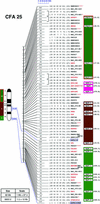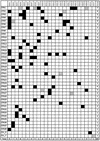A 1-Mb resolution radiation hybrid map of the canine genome
- PMID: 12700351
- PMCID: PMC154339
- DOI: 10.1073/pnas.0831002100
A 1-Mb resolution radiation hybrid map of the canine genome
Abstract
The purebred dog population consists of >300 partially inbred genetic isolates or breeds. Restriction of gene flow between breeds, together with strong selection for traits, has led to the establishment of a unique resource for dissecting the genetic basis of simple and complex mammalian traits. Toward this end, we present a comprehensive radiation hybrid map of the canine genome composed of 3,270 markers including 1,596 microsatellite-based markers, 900 cloned gene sequences and ESTs, 668 canine-specific bacterial artificial chromosome (BAC) ends, and 106 sequence-tagged sites. The map was constructed by using the RHDF5000-2 whole-genome radiation hybrid panel and computed by using MULTIMAP and TSP/CONCORDE. The 3,270 markers map to 3,021 unique positions and define an average intermarker distance corresponding to 1 Mb. We also define a minimal screening set of 325 highly informative well spaced markers, to be used in the initiation of genome-wide scans. The well defined synteny between the dog and human genomes, established in part as a function of this work by the identification of 85 conserved fragments, will allow follow-up of initial findings of linkage by selection of candidate genes from the human genome sequence. This work continues to define the canine system as the method of choice in the pursuit of the genes causing mammalian variation and disease.
Figures


References
Publication types
MeSH terms
Grants and funding
LinkOut - more resources
Full Text Sources
Other Literature Sources
Miscellaneous

